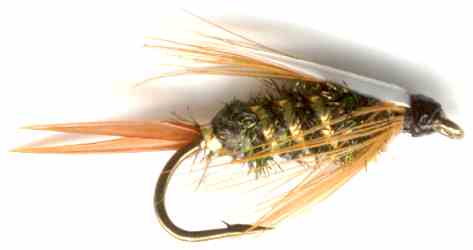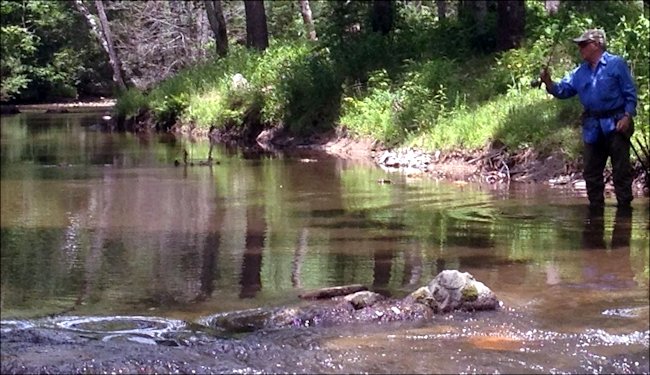The Prince's Nymph Fly
The Prince's Nymph is one of those must have flies. It rates along with Pheasant Tail nymphs, Gold Ribbed Hare's Ear nymphs and Zug Bug as one of the top 10 nymphs that you must have in your fly box.

NYMPH FLY PATTERNS. Hook size 10 12 14 16 18 20 - $US each
It is the use of the green peacock herl with it's efflorescent qualities that makes the Prince's Nymph fly so alluring and successful. This forked tail nymph originated with the brothers Don and Dick Olson of Bemidji, Minnesotas, USA, but it was made popular in Western North America by Doug Prince of Monerey, California from whom it gets it's name
My preferred method of fly fishing for trout is to use a team of two nymphs dangling on droppers under a dry fly which I use as a strike indicator. This method is known as the New Zealand style of nymph fly fishing by some. I had been using this set up for years and knew it as the team of three before I was told that it had a name. My choice of dry fly will depend on the water conditions. If the river is rough then I will use a very buoyant fly like a Wulff or Adams indispensable. In calmer conditions I like to use a parachute dry fly or a Klinkhammer. The white post on these flies helps with visibility. Always apply floatant to the dry fly to keep it from getting waterlogged and sinking.
I use a 9 foot tapered leader from the line to the dry fly. The length of tippet will depend on the depth of the water. I normally use a 4lb fluorocarbon. One end is attached to the bend in the hook of the dry and a dropper added with a three turn water knot to create the dropper two feet below the dry fly. I always put the heaviest nymph on the point so that the cast will turn over. A good choice is a beaded princes nymph with a normal prince’s nymph in the middle.
Many beginners have problems casting a team of three flies. When you are casting exaggerate the forward stroke and cast a wider, more open loop so that the flies are kept apart and turn over properly. This method of fly fishing is great because not only are you fishing a dry fly on the surface but you are also fishing two nymphs at different depths in the water column. I visually section up the river and work each area before moving on to the next. I start from one bank and gradually progress to the other side so that nor river fish-holding spots are missed. Keep loops of line in your spare hand rather than let it drop onto the water surface. To get the maximum fishing timeout of each cast let the flies drift past and let them swing up in the current. That way you are fishing the dead drift and also the lift, which is when a lot of takes can happen.
Customer's Comment
I fish the Pequest River in New Jersey. It is the stretch that flows from the spillway that leaves the Pequest hatchery. One of the top trout catching early season flies are your Prince’s nymphs in hook size 14-16. Tight Lines Dude, Fred Ungaretta NJ,USA
Linkedin Reader's Comment
Another area that I laugh at all the time is the old adage "Match the hatch!". The problem there is the fish, genetically, prefer the emerger over anything that has left the water and, usually, by the time there has been enough hatch to tell what it is the fish are full and no longer feeding. (You're fly is kind of like waving an overcooked piece of spinach in front of somebody that just finished a 5 course dinner.) Use a fly that resembles an emerging insect like a Princes Nymph. 80% of a Trout's food is taken under the water. by Phil Granger

Customer's Photo
Almost all of my fishing these days is in the Blue Ridge Mountains of North Carolina. Until recent years I enjoyed finding wild trout, usually brookies, in the small streams in the upper reaches of these mountains. I have given that up because my 84 year old knees complain too much about the climbing and the rock-hopping, so I now visit the slower, easier-access places, most of which are at lower elevations and are stocked in the spring and fall by the state. Our mountains are very old and as such are not the craggy peak kind. The highest peak this side of the western US mountains is in NC, but it tops out at only 6500 feet, which is modest as mountains go. Most of the trout streams are relatively narrow, usually less than 30 feet wide, frequently have steep, rocky gradients and sometimes exposed granite bedrock.
As for flies, we do not see big hatches and the fish in these tumbling streams are opportunists; the trick is to get something in front of them without scaring them and I don’t think it matters much which fly is coming their way. The Wulff, Humpy, and Goddards Caddis are all good choices, but I have always favored wet flies, and soft hackles are my favorite. This year I began to tie a simple wooly worm with peacock hurl and brown grizzly hackle, no tail, on a size 12 hook wrapped with wire. I had good luck last spring using it for stocked fish and like it for the first fly of the day, especially if the sky is cloudy. I like to put on the soft hackles when the sun reaches me, and I will swing a Royal Wulff or a Prince Nymph down a riffle if it looks right. I usually hire a guide for the first trip to new water but prefer to go it alone thereafter, or with one of my few remaining companions. To be honest, I am a somewhat lazy, ill-educated fisher, no longer looking for large fish and happy with any activity during the day. I throw them all back and have learned to get a fish off the hook with little or no hand contact. (I consider this feat worthy of note, even if few others are impressed.) Gregory P. Chacos NC, USA
Customer's Comment
The Prince’s Nymph fly pattern is a real fish catcher. I fish with three of these flies on droppers with the biggest hook on the point. I also use it as the sandwich filler between two flashier patterns above and below it. The beauty of this nymph is its ability to represent a whole host of items in the trout’s diet. It can be fished slow or pulled like a streamer. It seems to work no matter the retrieve. It is not just a pattern for Rainbow Trout. I have found the Princes Nymph very effective with brown trout as well, which really proves how good a pattern this is. Geoff Jameson PA, USA


Fly Fishing books

